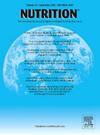Evaluating plate waste in Lebanese hospitals: Implications for nutrition and resource management
IF 3.2
3区 医学
Q2 NUTRITION & DIETETICS
引用次数: 0
Abstract
Objectives
This study aimed to quantify plate waste in Lebanese hospitals and evaluate the nutritional value.
Methods
A descriptive cross-sectional study was conducted between April 2023 and September 2023. It involved 155 inpatients from cardiovascular, gastrointestinal, obstetrics-gynecology and surgical wards across 16 hospitals throughout the Lebanese governorates. Plate waste was measured using a calibrated scale by measuring the food sent to the patient (before consumption) and the food left on the plate (after consumption) and computing the percentage of waste by dividing the grams discarded over the grams served, or through visual estimation. Nutritional analysis was performed to assess the magnitude of waste and its nutritional value.
Results
The plate waste represented 31.4% of the total amount of food served, equivalent to 366 tons annually in the participating hospitals. The discarded food accounted for 21.4% of the daily estimated energy requirement for patients. Waste was higher in hospitals located in rural areas (P-value = 0.771). The highest waste levels occurred in the obstetrics-gynecology ward and during lunchtime. On average, each patient wasted 404.7 kcal and 21.16 g protein per day. Vegetables were the most wasted food group. The highest mean daily plate waste was for lunch, representing 37.4% of the wasted weight, followed by dinner (35.6%), then breakfast (12.8%).
Conclusion
Lebanese hospitals should take pivotal steps to reduce plate waste, lessen its impacts and eventually increase patients’ satisfaction, as well as adopt relevant and efficient strategies to manage the waste generated, as this waste negatively impacts the environment, and puts patients at risk for malnutrition, hidden hunger, and even death.

评估黎巴嫩医院的餐盘浪费:对营养和资源管理的影响
目的对黎巴嫩医院的餐盘浪费进行量化,并对其营养价值进行评价。方法于2023年4月至2023年9月进行描述性横断面研究。调查涉及黎巴嫩各省16家医院心血管、胃肠、妇产科和外科病房的155名住院病人。盘子浪费是通过测量送到病人的食物(食用前)和留在盘子上的食物(食用后)来测量的,并通过将丢弃的克数除以提供的克数来计算浪费的百分比,或者通过视觉估计。进行营养分析以评估废物的大小及其营养价值。结果参与医院餐盘浪费占总餐量的31.4%,相当于366吨/年。被丢弃的食物占患者每日估计能量需求的21.4%。农村地区医院废弃物较高(p值= 0.771)。最严重的浪费发生在妇产科病房和午餐时间。平均每人每天浪费404.7千卡热量和21.16克蛋白质。蔬菜是浪费最多的食物。平均每日浪费盘子最多的是午餐,占浪费重量的37.4%,其次是晚餐(35.6%),然后是早餐(12.8%)。结论黎巴嫩医院应采取关键措施,减少餐盘浪费,减少其影响,最终提高患者满意度,并采取相关和有效的策略来管理产生的废物,因为这些废物对环境产生负面影响,并使患者面临营养不良、隐性饥饿甚至死亡的风险。
本文章由计算机程序翻译,如有差异,请以英文原文为准。
求助全文
约1分钟内获得全文
求助全文
来源期刊

Nutrition
医学-营养学
CiteScore
7.80
自引率
2.30%
发文量
300
审稿时长
60 days
期刊介绍:
Nutrition has an open access mirror journal Nutrition: X, sharing the same aims and scope, editorial team, submission system and rigorous peer review.
Founded by Michael M. Meguid in the early 1980''s, Nutrition presents advances in nutrition research and science, informs its readers on new and advancing technologies and data in clinical nutrition practice, encourages the application of outcomes research and meta-analyses to problems in patient-related nutrition; and seeks to help clarify and set the research, policy and practice agenda for nutrition science to enhance human well-being in the years ahead.
 求助内容:
求助内容: 应助结果提醒方式:
应助结果提醒方式:


